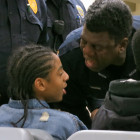
Law Expert Lays out Legal Trends in Childrens’ Cases
|
Some of the most important questions about evidence in child welfare cases now rolling through courts have to do with Shaken Baby Syndrome.
Juvenile Justice Information Exchange (https://jjie.org/tag/events/)

Some of the most important questions about evidence in child welfare cases now rolling through courts have to do with Shaken Baby Syndrome.

The National Association of Counsel for Children 36th National Child Welfare, Juvenile, and Family Law Conference opens this morning.

(Sony Pictures Classics, R)
Equality before the law is a basic principle of the American justice system. Faith in the jury system is another cornerstone of our system, and the wisdom of allowing local control in policing and justice matters is a third. All three come in for harsh criticism in West of Memphis, Amy Berg’s new documentary about the West Memphis Three, whose trial, conviction, and appeal has also been covered in the Paradise Lost trilogy of documentaries by Joe Berlinger and Bruce Sinofsky. The West Memphis Three—Jessie Misskelley, Damien Echols, and Jason Baldwin—were teenagers in 1993 when they were charged with murdering three 8-year-old boys in West Memphis, Arkansas. This crime drew widespread publicity due to its horrifying nature: the bodies of the murdered children were discovered, naked and hogtied, in a local creek, and appeared to have been sexually mutilated.
On Nov. 7, the National Juvenile Justice Network (NJJN) will hold a webinar focusing on the new Models For Change publication “Washington Judicial Colloquies Project: A Guide for Improving Communication and Understanding in Court.”
The guide, published by Washington State NJJN member TeamChild, offers advice on how professionals can better explain and describe the legal language used in court proceedings to young people. Working with the National Juvenile Defender Center and the Juvenile Indigent Defense Action Network, TeamChild created a guide that suggests “colloquies,” pre-written language for judges and attorneys to use during young people’s first court appearances and further disposition hearings. The language is written at a 6th grade-level and designed to be easily understood by juveniles. In fact, according to the the guide, effective use of colloquies sometimes increased young people’s understanding of release and probation conditions from one third to 90 percent after hearings.

In what organizers say is the first event of its kind in the Pacific northwest, Oregon juvenile justice advocates will hold a 5K run/walk this month to publicize a campaign to channel the state’s 15-, 16- and 17-year-olds toward juvenile court. “In 2009, my 15-year-old was convicted as an adult,” said April Rains, a board member of the Partnership for Safety and Justice, a nonprofit group that aims to make Oregon’s approach to public safety more effective and just. “I knew that he needed to be held accountable for what he did,” said Rains, a one-time victim advocate. But, “what was shocking was how little support I got for my son and my family. He was a good kid, was involved with church, loved learning, loved taking care of animals.

Tuesday, Juvenile-in-Justice: Photographs by Richard Ross will premiere at Kennesaw State University (KSU), with a public lecture by the 2012 recipient of the National Magazine Award for News and Documentary Photography scheduled at 5 p.m. in the Prillaman Hall auditorium. For five years, Ross visited more than 350 detention centers, treatment facilities, juvenile courtrooms and maximum-security lock-down shelters, documenting the daily lives of America’s incarcerated young people. Ross’s work, organized by the Nevada Museum of Art and sponsored by the Wilhelm Hoppe Family Trust, was recently featured in Harper’s Magazine, in addition to making appearances on Wired.com and Picture Dept., a site operated by the photo editors at Newsweek and The Daily Beast. Earlier this year, ProPublica listed “Juvenile-in-Justice” as one of the year’s five best investigative reports on prisons. And the American Society of Magazine Editors (AMSE) and the Columbia University Graduate School of Journalism praised Ross’ photo essay, calling it the best news and documentary photography of 2012.

Four years after a Missouri mother started a homemade campaign about the judicial system that led to her son’s suicide in prison, more than half of the states are hosting events aimed at increasing awareness of the treatment of youth in adult courts, jails and prisons. “I couldn’t fathom the treatment he received. I mean I was really scared,” said Tracy McClard, originator of Youth Justice Awareness Month, marked every October. She started the awareness campaign in 2008 with a 5k run/walk. It’s in memory of her son Jonathan, who hung himself three days after his 17th birthday rather than face 30 years in prison.

On September 12, the National Center for Youth in Custody (NC4YC) - launched by the federal Office of Juvenile Justice and Delinquency Prevention (OJJDP) in 2010 - will host a webinar titled Creating and Sustaining Improved Conditions for Youth in Custody: Beyond the Initial External Influence. The webinar, the first in a series that will explore and address sustainable and comprehensive means of improving confinement conditions for detained youth, focuses on ways for facility managers to create safer, more secure and more therapeutic environments for juveniles in custody. The event will be moderated by Dr. David Roush of the National Center for Youth in Custody, and scheduled panelists include Department of Justice representative Josh Delaney; Youth Law Center Executive Director Jennifer Rodriguez; Martinez-Tjaden, LLP, founder and senior partner Orlando Martinez; and Teresa Abreu, interim director of the Cook County Juvenile Temporary Detention Center in Illinois. The webinar is scheduled for 90 minutes, and will begin at 2 p.m. EST. Attendees can register for the free event at the following website: https://www3.gotomeeting.com/register/307620422

The controversial A&E Network series “Beyond Scared Straight” returns August 20 for a third season. If this 30-second teaser from A&E is any indication, viewers can expect more episodes filled with inmates and prison guards yelling at, verbally abusing and intimidating at-risk teens.

Lorena Padron, 18, and Maria Calderon, 19, were all smiles this afternoon as they flanked Governor Nathan Deal in his office. With a stroke of a pen, the governor signed HB 373 into law, giving both of them and thousands of others with a track record of good behavior and academic success in Georgia’s Regional Youth Detention Centers (RYDCs) and Youth Development Centers (YDCs) a chance to substantially reduce their time in custody. Known as the “Good Behavior bill,” the measure passed in the 2011 legislative session that ended last month also gives juvenile court judges more discretion. “I feel very good, I’m very happy,” said Padron, after the signing ceremony at the state capitol. “I feel like I can begin my life again, like I’ll be able to go home and help my family.